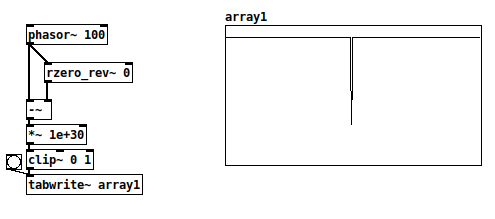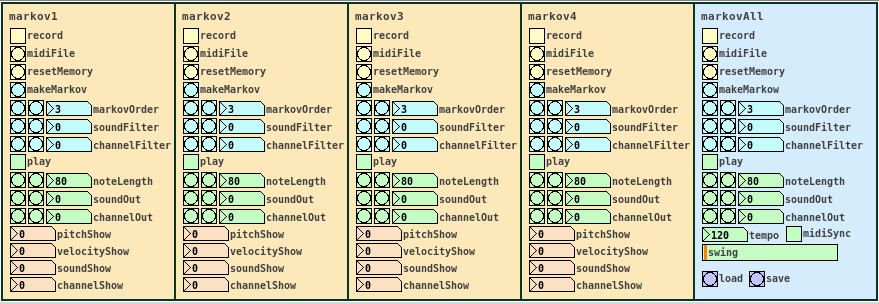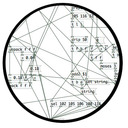Taking and saving an image to a file every 3 seconds
@Still said:
I was wondering if there are any examples of using PD to take images from a USB camera every 3 seconds or so and saving the image out to individual filenames that includes the time stamp in the filename.
My goal is to create a poor mans DAQ (data acquisition) using PD, a multi-meter, and image recognition.
My thought process:
PD plays audio signal that increases over time for a duration of 3 second, then appends the signal value that was played to a text file with a time stamp.
Have usb take camera shot every 3 seconds of a digital multi-meter screen and output that to a file with the time stamp in the filename.
Use machine learning / OCR on image files and append the decoded OCR numerical data to another text file that includes a time stamped text value from the filename so I can sync up the original signal played and the value that comes from the multi-meter output.
Plot the values from text file showing input signal vs output signal
PS I'm using Ubuntu 20.04 Linux.
If anyone has another way of doing this please let me know.Thanks
@whale-av said:
@Still What is the multi-meter reading?
If it is an audio level then you could bring the data back into Pd from a microphone and plot the level against the level of output from Pd.
Image capture could be done in Pd with GEM but the data will be huge and OCR is not a Pd function that I know of.
Using a microphone instead would bypass those stages....... and the plot could even be presented in real time.
David.
It's a voltage level around 200+ volts. It's measuring non-linear vortex inductor coils. When you input different audio signals it outputs very high voltages and very low voltages .1 to 200+ volts (very non linear). So I don't think I could bring that data back in easily. I would do the OCR using python or Octave.
Windowed-sync oscillator: Style questions
@jameslo "Since many programmers seem to want to avoid [fexpr~] at all costs, maybe you could rewrite your [fexpr~] with [expr~ $v1 > $v2] and [rzero_rev~ 0]"
Hmm, yeah. I had thought that both [expr~] and [fexpr~] were said to be bad for performance.
I suppose this might be another way to do a signal-rate comparison:

There's a very small chance of the [-~] result being between 0 and 1e-30, where the clip~ value would be between zero and one but not exactly either. With typical signal magnitudes, that's unlikely, so this wouldn't work in cases where only 0 and 1 are acceptable.
+1 RE the mystifying omissions and irregularities in vanilla. Since I started thinking of it as a scripting language (and stopped comparing it to c, c++, c#, Java...) everything became happy and easy-going.
Yes and no... Pd is an important and valuable tool and it's good to make friends with it as it is. At the same time, lack of some core operators can be seen as a usability issue.
I definitely wouldn't compare it to C and such. Miller Puckette himself acknowledges[1] that many algorithms are straightforward to write in procedural languages (and maybe even more straightforward in functional languages), but rip-your-hair-out painful in dataflow patchers. E.g., quicksort, which in Haskell goes:
quicksort :: Ord a => [a] -> [a]
quicksort [] = []
quicksort (p:xs) = (quicksort lesser) ++ [p] ++ (quicksort greater)
where
lesser = filter (< p) xs
greater = filter (>= p) xs
and in C is... somewhat longer but still a fairly straightforward recursive implementation.
I can literally not even imagine how to implement a quicksort in Pd.
In SuperCollider, I'm doing most of my performances using a sequence-scripting language of my own design, where SC code is parsing the expressions and translating them into SC patterns. That's been a long project but within reach of an object-oriented language with a full suite of data structures. Pd... again, I can't imagine where to begin.
Puckette points out in that interview that Max and Pd are designed to react to input events, and they are very elegant for this. In Pd, you can connect a slider to a number box. In SC, the same is:
(
var number, slider;
w = Window("slider", Rect(800, 200, 500, 400)).front;
w.layout = VLayout(
nil,
HLayout(
number = NumberBox().fixedWidth_(80),
slider = Slider().orientation_(\horizontal)
),
nil
);
slider.action = { |view|
number.value = view.value;
};
)
In that case, definitely, Pd's expression of the idea of a value flowing from an interface object toward the display object is as concise as you can imagine, and SC's version is verbose and puzzling until you get used to it. Use the tool that's right for the job.
lacuna:
There are [vphasor~], [vphasor2~] and [vsamphold~] from @Maelstorm .
Oh that's good.
It's hard to find extensions like this, if you don't know where it is.
In your patch [rpole~ 1] is working with a signal-inlet, isn't it?
Yes. The idea is, while the (signal) coefficient is 1, then the left-hand signal gets integrated. If, for a single sample, both the signal and coefficient are 0, then the output is 0, and it will start integrating again as soon as the coefficient flips back to 1.
Which is that other forum you mentioned?
TBH I think SC wins in terms of clear expression of this synthesis algorithm:
(
{
var sync = LFTri.ar(SinOsc.kr(0.2).exprange(100, 400));
var phase = Sweep.ar(sync, SinOsc.kr(0.12743).exprange(700/3, 2100));
var synced = SinOsc.ar(0, (phase % 1) * 2pi);
dup(LeakDC.ar(synced * sync) * 0.1)
}.play;
)
This is part of what I mean by "usability issues" -- Pd: 7 objects for the triangle wave vs SC: LFTri.ar(freq), or the automatic exponential scaling exprange, and Sweep has a signal-rate retrigger built-in (there's also a range-rewrapping Phasor, and it has an audio-rate trigger too)... SC's initial learning curve is steeper but once you know it well, it took a couple of minutes to write that, vs 30-40 minutes (including head-scratching time) in Pd. (Admittedly I'm less fluent in Pd.)
hjh
[1] https://omny.fm/shows/future-of-coding/47-maxmsp-pure-data-miller-puckette
Need help understanding compression patch
@djpersonalspace
yeah, approximately (because you always measure a mean dB value with [env] depending on its window size). or exactly, the part of the signal, which exceeds threshold level - in this case, it would works as an upward-expander: the signal below threshold level would be left untouched, while the part of the signal, which exceeds it, will be amplified towards the reference value. a constant sine wave is not really illustrative for this purpose, try it witch a dynamic sample loop. have a look here, i added a small loop sampler abstraction to your patch.
compsampler.zip
in most cases, you will not want to use the compressor like this:
the benefit of a compressor is, that it attenuates peaks above a given threshhold by a given ratio, which at first makes the signal quiter. after the compression, you can then increase the volume again. the effect is, that the mean-loudness of the signal is higher than before compression. this is why most compressors have so calles "makeup" control to adjust the level of the compressed signal. in addition, you could also add a gain control, for the input level.
if you want to use the compressor the usual way, you can simply save on the reference control an put the threshold control in its place, so you have the same level for both parameters. although you wont be able to use it as expander anymore.
the compression factor is pretty much the same as in usual compressors: a factor of 10 is equal to a ratio of 1:10, a factor of 2, would mean 1:2 as ratio.... this means that the level of the signal above the threshold will be halved (towards the threshold level (which the is the equal to the reference level).
MIDI into [seq] and Markov chains
@weightless Yes, now as time has past, i wonder if the markovGenerator could be optimized in several ways. We started with this famous Pd Markov chain tutorial that floats around on the Internet, but it has several flaws, as it is limited to second order Markov chains, skips the first notes and stops if it reaches the end.
In markovGenerator, we implemented a system that can handle chains of any order, incorporates all notes, views the source material as a loop and therefor never stops, and supports polyphony, as it treads chords as one item.
To realize longer chains, all input is encoded as symbols, where "?" is put between notes of one chord and "#" is put between the elements of the chain (if i remember correctly). This way, it is possible to generate the current chain and to search for it in the [text] that holds all chains and the possible follow up notes 
Throw~ for dynamically created audio signals
@amirt The [catch~] will add all the signals together so the output signal will have to be reduced. It is hard though to know exactly the resultant level..... it will depend upon what is being sent.
If every [throw~] is sending an [osc~] output signal then divide the [catch~] output by the number of throwers...... https://forum.pdpatchrepo.info/topic/10018/does-throw-really-sum-signals/3
If only one [throw~] is ever sending a signal then the divide is unnecessary.
If your [throw~] levels are unknown then that presents a conundrum.
In the "zexy" library there is a "feed forward" [limiter~] setup in the [limiter~] help file, which, if a small extra delay is acceptable, would keep the signal in range, but probably sound compressed.
You could then divide by a smaller number........ and follow that with a limiter.
David
[small job offer] porting max external to pd
Edit 1: Took a shot porting it in this little textarea. Probably doesn't compile yet...
Edit 2: Ok, this should compile now. I haven't actually tried to instantiate it yet, though. It's possible I set it up with the wrong number of xlets.
Edit 3: Seems to instantiate ok. It appears it doesn't take signal input so the CLASS_MAINSIGNALIN macro is neccessary. Just comment that part out to make it a control signal.
Note-- in my port it's called [vb_fourses~] for the reason noted below.
I have no idea if the algorithm behaves correctly, but it does output sound.
Btw-- AFAICT you should be able to compile this external for the 64-bit version of Purr Data and it should work properly. It doesn't require a special 64-bit codepath in Pd so I commented that part out.
Btw 2-- there should probably be a "best practices" rule that states you can only name your class something that is a legal C function name. Because this class doesn't follow that practice I made a mistake in the port. Further, the user will make a mistake because I had to change the class name. If I had instead made the setup function a different name than the creator I would create an additional problem that would force users to declare the lib before using it. Bad all around, and not worth whatever benefit there is to naming a class "foo.bar" instead of "foo_bar"
/*
#include "ext.h"
#include "ext_obex.h"
#include "z_dsp.h"
#include "ext_common.h"
*/
#include "m_pd.h"
#include "math.h"
/*
a chaotic oscillator network
based on descriptions of the 'fourses system' by ciat-lonbarde
www.ciat-lonbarde.net
07.april 2013, volker b?hm
*/
#define NUMFOURSES 4
static void *myObj_class;
typedef struct {
// this is a horse... basically a ramp generator
double val;
double inc;
double dec;
double adder;
double incy, incym1; // used for smoothing
double decy, decym1; // used for smoothing
} t_horse;
typedef struct {
t_object x_obj;
double r_sr;
t_horse fourses[NUMFOURSES+2]; // four horses make a fourse...
double smoother;
t_sample x_f;
} t_myObj;
// absolute limits
static void myObj_hilim(t_myObj *x, t_floatarg input);
static void myObj_lolim(t_myObj *x, t_floatarg input);
// up and down freqs for all oscillators
static void myObj_upfreq(t_myObj *x, t_floatarg freq1, t_floatarg freq2, t_floatarg freq3, t_floatarg freq4);
static void myObj_downfreq(t_myObj *x, t_floatarg freq1, t_floatarg freq2, t_floatarg freq3, t_floatarg freq4);
static void myObj_smooth(t_myObj *x, t_floatarg input);
static void myObj_info(t_myObj *x);
// DSP methods
static void myObj_dsp(t_myObj *x, t_signal **sp);
static t_int *myObj_perform(t_int *w);
//void myObj_dsp64(t_myObj *x, t_object *dsp64, short *count, double samplerate,
// long maxvectorsize, long flags);
//void myObj_perform64(t_myObj *x, t_object *dsp64, double **ins, long numins,
// double **outs, long numouts, long sampleframes, long flags, void *userparam);
//
static void *myObj_new( t_symbol *s, int argc, t_atom *argv);
//void myObj_assist(t_myObj *x, void *b, long m, long a, char *s);
void vb_fourses_tilde_setup(void) {
t_class *c;
myObj_class = class_new(gensym("vb_fourses~"), (t_newmethod)myObj_new, 0, sizeof(t_myObj),
0, A_GIMME, NULL);
c = myObj_class;
class_addmethod(c, (t_method)myObj_dsp, gensym("dsp"), A_CANT, 0);
// class_addmethod(c, (t_method)myObj_dsp64, gensym("dsp64"), A_CANT, 0);
class_addmethod(c, (t_method)myObj_smooth, gensym("smooth"), A_FLOAT, 0);
class_addmethod(c, (t_method)myObj_hilim, gensym("hilim"), A_FLOAT, 0);
class_addmethod(c, (t_method)myObj_lolim, gensym("lolim"), A_FLOAT, 0);
class_addmethod(c, (t_method)myObj_upfreq, gensym("upfreq"), A_FLOAT, A_FLOAT, A_FLOAT, A_FLOAT, 0);
class_addmethod(c, (t_method)myObj_downfreq, gensym("downfreq"), A_FLOAT, A_FLOAT, A_FLOAT, A_FLOAT, 0);
class_addmethod(c, (t_method)myObj_info, gensym("info"), 0);
//class_addmethod(c, (t_method)myObj_assist, "assist", A_CANT,0);
CLASS_MAINSIGNALIN(myObj_class, t_myObj, x_f);
// class_dspinit(c);
// class_register(CLASS_BOX, c);
post("vb_fourses~ by volker b?hm\n");
// return 0;
}
static void myObj_smooth(t_myObj *x, t_floatarg input) {
// input = CLAMP(input, 0., 1.);
if (input < 0.) input = 0;
if (input > 1.) input = 1;
x->smoother = 0.01 - pow(input,0.2)*0.01;
}
static void myObj_hilim(t_myObj *x, t_floatarg input) {
x->fourses[0].val = input; // store global high limit in fourses[0]
}
static void myObj_lolim(t_myObj *x, t_floatarg input) {
x->fourses[5].val = input; // store global low limit in fourses[5]
}
static void myObj_upfreq(t_myObj *x, t_floatarg freq1, t_floatarg freq2, t_floatarg freq3, t_floatarg freq4) {
x->fourses[1].inc = fabs(freq1)*4*x->r_sr;
x->fourses[2].inc = fabs(freq2)*4*x->r_sr;
x->fourses[3].inc = fabs(freq3)*4*x->r_sr;
x->fourses[4].inc = fabs(freq4)*4*x->r_sr;
}
static void myObj_downfreq(t_myObj *x, t_floatarg freq1, t_floatarg freq2, t_floatarg freq3, t_floatarg freq4) {
x->fourses[1].dec = fabs(freq1)*-4*x->r_sr;
x->fourses[2].dec = fabs(freq2)*-4*x->r_sr;
x->fourses[3].dec = fabs(freq3)*-4*x->r_sr;
x->fourses[4].dec = fabs(freq4)*-4*x->r_sr;
}
//#pragma mark 64bit dsp-loop ------------------
//void myObj_dsp64(t_myObj *x, t_object *dsp64, short *count, double samplerate,
// long maxvectorsize, long flags) {
// object_method(dsp64, gensym("dsp_add64"), x, myObj_perform64, 0, NULL);
//
// if(samplerate<=0) x->r_sr = 1.0/44100.0;
// else x->r_sr = 1.0/samplerate;
//
//
//}
//static void myObj_perform64(t_myObj *x, t_object *dsp64, double **ins, long numins,
// double **outs, long numouts, long sampleframes, long flags, void *userparam){
//
// t_double **output = outs;
// int vs = sampleframes;
// t_horse *fourses = x->fourses;
// double val, c, hilim, lolim;
// int i, n;
//
// if (x->x_obj.z_disabled)
// return;
//
// c = x->smoother;
// hilim = fourses[0].val;
// lolim = fourses[5].val;
//
// for(i=0; i<vs; i++)
// {
// for(n=1; n<=NUMFOURSES; n++) {
// // smoother
// fourses[n].incy = fourses[n].inc*c + fourses[n].incym1*(1-c);
// fourses[n].incym1 = fourses[n].incy;
//
// fourses[n].decy = fourses[n].dec*c + fourses[n].decym1*(1-c);
// fourses[n].decym1 = fourses[n].decy;
//
// val = fourses[n].val;
// val += fourses[n].adder;
//
// if(val <= fourses[n+1].val || val <= lolim ) {
// fourses[n].adder = fourses[n].incy;
// }
// else if( val >= fourses[n-1].val || val >= hilim ) {
// fourses[n].adder = fourses[n].decy;
// }
//
// output[n-1][i] = val;
//
// fourses[n].val = val;
// }
// }
//
// return;
//
//}
//#pragma mark 32bit dsp-loop ------------------
static void myObj_dsp(t_myObj *x, t_signal **sp)
{
dsp_add(myObj_perform, 6, x, sp[0]->s_vec, sp[1]->s_vec, sp[2]->s_vec, sp[3]->s_vec, sp[0]->s_n);
if(sp[0]->s_sr<=0)
x->r_sr = 1.0/44100.0;
else x->r_sr = 1.0/sp[0]->s_sr;
}
static t_int *myObj_perform(t_int *w)
{
t_myObj *x = (t_myObj*)(w[1]);
t_float *out1 = (float *)(w[2]);
t_float *out2 = (float *)(w[3]);
t_float *out3 = (float *)(w[4]);
t_float *out4 = (float *)(w[5]);
int vs = (int)(w[6]);
// Hm... not sure about this member. I don't think we can disable individual
// objects in Pd...
// if (x->x_obj.z_disabled)
// goto out;
t_horse *fourses = x->fourses;
double val, c, hilim, lolim;
int i, n;
c = x->smoother;
hilim = fourses[0].val;
lolim = fourses[5].val;
for(i=0; i<vs; i++)
{
for(n=1; n<=NUMFOURSES; n++) {
// smoother
fourses[n].incy = fourses[n].inc*c + fourses[n].incym1*(1-c);
fourses[n].incym1 = fourses[n].incy;
fourses[n].decy = fourses[n].dec*c + fourses[n].decym1*(1-c);
fourses[n].decym1 = fourses[n].decy;
val = fourses[n].val;
val += fourses[n].adder;
if(val <= fourses[n+1].val || val <= lolim ) {
fourses[n].adder = fourses[n].incy;
}
else if( val >= fourses[n-1].val || val >= hilim ) {
fourses[n].adder = fourses[n].decy;
}
fourses[n].val = val;
}
out1[i] = fourses[1].val;
out2[i] = fourses[2].val;
out3[i] = fourses[3].val;
out4[i] = fourses[4].val;
}
//out:
return w+7;
}
static void myObj_info(t_myObj *x) {
int i;
// only fourses 1 to 4 are used
post("----- fourses.info -------");
for(i=1; i<=NUMFOURSES; i++) {
post("fourses[%ld].val = %f", i, x->fourses[i].val);
post("fourses[%ld].inc = %f", i, x->fourses[i].inc);
post("fourses[%ld].dec = %f", i, x->fourses[i].dec);
post("fourses[%ld].adder = %f", i, x->fourses[i].adder);
}
post("------ end -------");
}
void *myObj_new(t_symbol *s, int argc, t_atom *argv)
{
t_myObj *x = (t_myObj *)pd_new(myObj_class);
// dsp_setup((t_pxobject*)x, 0);
outlet_new((t_object *)x, &s_signal);
outlet_new((t_object *)x, &s_signal);
outlet_new((t_object *)x, &s_signal);
outlet_new((t_object *)x, &s_signal);
x->r_sr = 1.0/sys_getsr();
if(sys_getsr() <= 0)
x->r_sr = 1.0/44100.f;
int i;
for(i=1; i<=NUMFOURSES; i++) {
x->fourses[i].val = 0.;
x->fourses[i].inc = 0.01;
x->fourses[i].dec = -0.01;
x->fourses[i].adder = x->fourses[i].inc;
}
x->fourses[0].val = 1.; // dummy 'horse' only used as high limit for fourses[1]
x->fourses[5].val = -1.; // dummy 'horse' only used as low limit for fourses[4]
x->smoother = 0.01;
return x;
}
//void myObj_assist(t_myObj *x, void *b, long m, long a, char *s) {
// if (m==1) {
// switch(a) {
// case 0: sprintf (s,"message inlet"); break;
// }
// }
// else {
// switch(a) {
// case 0: sprintf (s,"(signal) signal out osc1"); break;
// case 1: sprintf(s, "(signal) signal out osc2"); break;
// case 2: sprintf(s, "(signal) signal out osc3"); break;
// case 3: sprintf(s, "(signal) signal out osc4"); break;
// }
//
// }
//}
martin brinkmann patch on Raspberry Pi
In general everything is working, I can also run my own patches without any problem, Only this patch (and some others) does not work correctly.
It looks like that the Watchdog is the problem
input channels = 2, output channels = 2
audio buffer set to 25
opened input device name hw:0
configuring sound input...
Sample width set to 4 bytes
configuring sound output...
Sample width set to 4 bytes
watchdog: signaling pd...
watchdog: signaling pd...
watchdog: signaling pd...
watchdog: signaling pd...
watchdog: signaling pd...
watchdog: signaling pd...
watchdog: signaling pd...
Cheers Marcus
[struct] / [pointer] object limitation?
I'm also curious about what triggers the Stack Overflow.
A safety mechanism that puts an upper limit on how deep an immediate "chain reaction" can be in response to an event like a mouse click, key press, netreceive, or clock callback (.e.,g. a bang coming from [delay 1000]). When I say "chain reaction", I mean an initial message to an object triggers an outgoing message to another object, and so on until there are no more outgoing messages to process. When I say "immediate", I mean the messages get sent without any logical time in between.
Here's an example:
[bng]
|
[bng]
|
[bng]
If you clicked the object chain above, you get an immediate chain reaction 3 objects deep.
Now, if you extended that chain so that there were 1001 [bng] objects-- each with a single connection to the next-- you'd get a stack overflow error because it exceeds the limit Pd puts on how deeply a single message is allowed to flow in an immediate chain reaction.
The way Pd is coded, these simple examples actually end up using recursive function calls in C. Using recursion with too many levels can end up overflowing the stack and cause a crash, which is why you get that particular error message. (1000 may be too small a number nowadays, but recursion is complex and I'm not sure how one would come up with a better number.)
When you use recursion explicitly in a Pd diagram-- that is, hooking an object's outlet to an inlet that is back up the chain-- you make it way more likely to hit this particular error. You can imagine that your recursive diagram ends up "unrolling". That is, if you have a chain of 4 objects where the bottom one connects back into the top one and recursing 251 times, you're going to hit a stack limit and get the error.
The [until] object solves this "explicit" recursion problem-- it sends a bang to its outlet, and when the resulting immediate chain reaction has finished it sends another until the specified limit is reached.
So if you have this:
[10000(
|
[until]
|
[bng]
|
[bng]
|
[bng]
You go two objects deep for the bang coming out of [until], then three more for the first time through the chain of [bng] objects. So now we're 5 deep. But once the first iteration of the [bng] objects are done they unroll, so we're back to being just 2 levels deep. Then the [until] object starts its next iteration, which goes 3 more deep, then unrolls. It can do this indefinitely, which is why [until] is preferred over using recursive object chains in Pd.
markovGenerator: A music generator based on Markov chains with variable length
Edit: There is a general [markov] abstraction now at https://forum.pdpatchrepo.info/topic/12147/midi-into-seq-and-markov-chains/45
This is one of the early projects by @Jona and me. Happy to finally release it. 
markovGenerator
Generates music from learned material using Markov chains. It is polyphonic, plays endlessly and supports Markov chains with variable length.
markovGenerator.zip (updated)
Usage:
- Record midi notes or load midi files
- Make Markov system
- Play

-
Record midi notes or load midi files
Until you reset the memory, each new recording will be added to the memory. The recorded material is seen as a loop, so that the last note is followed by the the first note, for endless play. markovGenerator handles recording midi and loading midi files differently: When you record midi, it will record notes according to the midi clock every sixth midi tick. This is defined in the counter in [pd midiclock]. So that way, breaks are being recorded and the rhythm is preserved. When loading midi files, no breaks are being recorded, the notes are just recorded in order, so the rhythm will be lost. In any case, simultaneous notes will be recorded as chords, so polyphony is preserved. -
Make Markov system
Set markovOrder to specify the length of the Markov chain. The higher the order, the more musical information will be kept, the lower the order, the more random it gets. You can use soundFilter and channelFilter to only use notes of the specified sound or channel. This is especially useful when working with midi files. Note that if there are no notes of the specified sound or channel, the Markov system will be empty and nothing will be played. Set the filters to zero to disable them. If you change the settings for the Markov system, click makeMarkov again for them to take effect. You can make new Markov systems with different settings out of the same recorded material over and over again, even when playing. If you record additional notes, click makeMarkov again to incorporate them into the Markov system. -
Play
While playing, you can change the note length, sound and midi out channel. Set soundOut and channelOut to zero to use the sound and channel information of the original material. Playing starts with the Markov chain of the last recorded notes, so the first note might be played first.
Use the markovAll section on the right to control all Markov channels at once. Here you can also set tempo, swing and midiSync, and you can save the project or load previous projects.
Have fun! 
If it does not play, make sure that
- you recorded some notes,
- you hit the makeMarkov button,
- soundFilter and channelFilter are not set to values where there are no notes. Try setting the filters to zero and hit makeMarkov again.
About the Markov system:
You can see the Markov system of each Markov channel in [text define $0markov]. Notes are stored as symbols, where the values are joined by "?". A note might look like 42?69?35?10 (pitch?velocity?sound?channel). Chords are joined by "=". A chord of two notes might look like 40?113?35?10=42?49?35?10. Notes and chords are joined to Markov chains by "-". The velocity values are not included in the chains. Sound and midi channel values are only included, if soundFilter or channelFilter are off, respectively. Markov chains of order three may look like 42?35?10-36?35?10=42?35?10-60?35?2 with filters off and simply like 42-37-40 with both filters active, only using the pitch value.
Requires Pd 0.47.1 with the libraries cyclone, zexy and list-abs.
Multiple signal outlets in external
Don't know if it really has something to do, but here's how I create signal inlets:
inlet_new(&x->obj, &x->obj.ob_pd, gensym("signal"), gensym("signal"));
and this is how I create signal outlets:
inlet_new(&x->obj, &x->obj.ob_pd, gensym("signal"), gensym("signal"));
I don't assign the inlets or outlets to any element of the object's data structure.
Since you use an argument in your new routine, I guess you want to use that to create as many outlets, right? You could probably do:
for(i = 0; i < f; i++) outlet_new(&x->obj, gensym("signal"));
I've used that in an external (with a hard-coded number of loop iterations, no argument) I've written and it does create four outlets without a problem.
And lastly, why do you return the pointer to the object with a cast to void? Shouldn't you just return x there? Also not sure if this has anything to do with your problem. I'm just comparing your code to code I've written for externals that works. Not a C guru...





